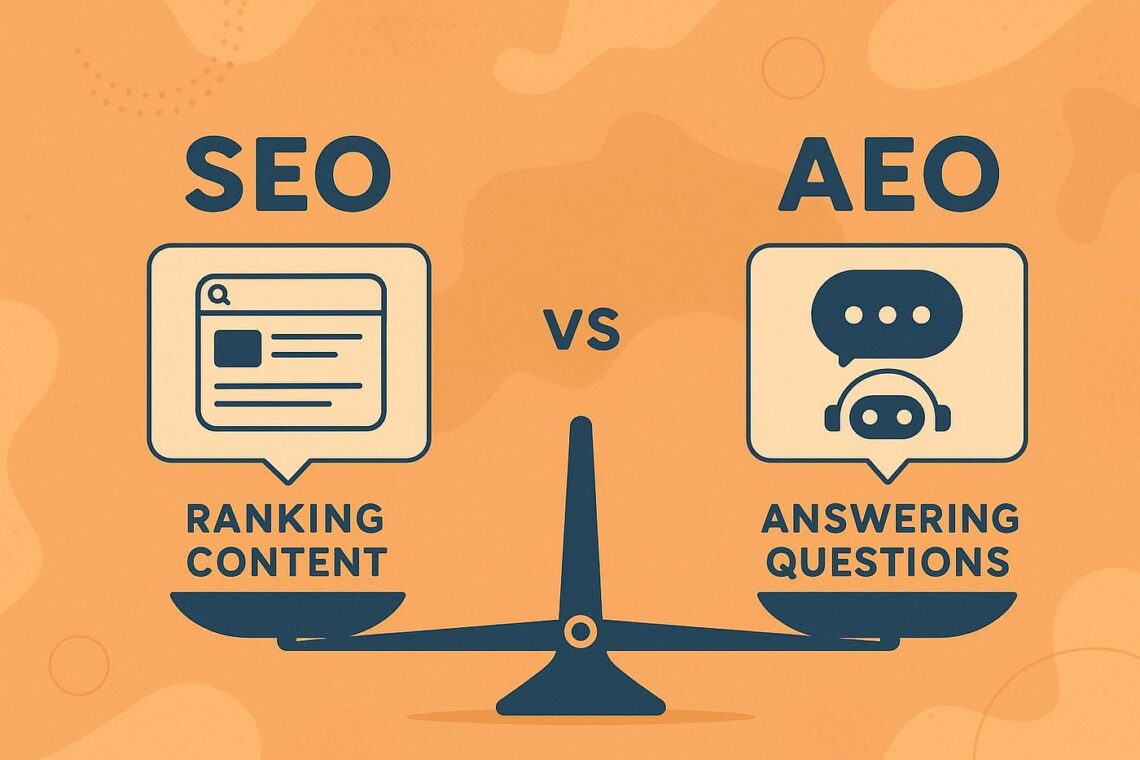
SEO vs. AEO
Search Engine Optimization and Answer Engine Optimization are two related but distinct approaches to making content discoverable online and by AI-driven systems.
Definitions
SEO focuses on improving a website’s visibility in traditional search engine results through keywords, technical optimization, backlinks, and content relevance.
AEO concentrates on helping content appear as direct answers within AI systems, voice assistants, and summarization features by providing concise, structured, and authoritative responses.
Core Differences
SEO prioritizes click-throughs, organic rankings, and site traffic as primary outcomes for success.
AEO prioritizes being surfaced directly inside answer boxes, AI summaries, and voice replies where the user may not click through to a site.
AEO typically rewards short, explicit answers and structured data; SEO often rewards depth, topical authority, and link signals.
Content and Structure
SEO content usually balances long-form explanations, internal linking, topic clusters, and on-page signals to demonstrate authority.
AEO content emphasizes clear question-and-answer formats, well-labeled sections, and markup that helps AI parse and reuse the material in concise outputs.
Both approaches benefit from accurate, well-sourced information and predictable content structure.
Technical Considerations
Technical SEO includes site speed, mobile usability, crawlability, canonicalization, and schema markup to help search engines index and rank pages.
AEO requires additional emphasis on structured snippets, FAQ-style blocks, short summary paragraphs, and metadata that AI agents can extract and cite.
Implementing both technical foundations improves the chance to appear both in search results and in AI-generated answers.
User Intent and Experience
SEO-driven content often aims to lead users into deeper site journeys, fostering exploration and conversions through internal navigation and related resources.
AEO-driven content aims to satisfy immediate informational intent, delivering a clear solution or definition quickly and efficiently for conversational queries.
Mapping content to different stages of intent allows brands to serve both users who want instant answers and those who want to engage further.
Distribution and Visibility
SEO success depends on ranking pages in result lists where multiple competitors vie for clicks and impressions.
AEO success depends on being the preferred source for an AI to synthesize or quote, which can drastically reduce direct site traffic but increase brand visibility within AI interfaces.
A balanced distribution approach seeks to win traditional rankings while also structuring content so it can be reused by answer engines.
Measurement and KPIs
SEO performance is measured by organic traffic, rankings, click-through rates, time on page, and conversions attributed to search.
AEO performance is measured by presence in answer features, impressions inside AI interfaces, branded query lift, and downstream engagement from users who follow up after receiving an AI answer.
Combining these KPIs gives a fuller picture of visibility and user behavior across both paradigms.
Content Strategy Recommendations
Create core pillar content that establishes topical authority while also producing concise answer blocks and FAQs that satisfy quick queries.
Use headings, lists, and schema to make both long-form and short-form content easy to parse for humans and machines.
Maintain versioned summaries at the top of long articles so answer engines can extract succinct, accurate replies.
Editorial and Production Workflow
Train writers to produce both a short, factual answer and an expanded explanation for each key question you target.
Adopt a content template that includes a headline question, a succinct answer, supporting detail, and structured data to increase chances in both SEO and AEO placements.
Review and refresh concise answers frequently to ensure they remain accurate and aligned with the latest information and brand voice.
Technical Implementation Checklist
Ensure pages load quickly and render correctly on mobile devices to satisfy both search engines and voice assistants.
Add relevant schema types and markup for FAQs, articles, and products so AI systems can confidently extract and attribute content.
Provide clear canonical tags, clean HTML structure, and accessible headers to reduce ambiguity when automated systems parse your content.
Risk Management and Brand Control
Be mindful that appearing as an answer can surface content out of context; craft short answers that cannot be easily misconstrued when extracted.
Monitor how AI summaries present your brand’s statements and be prepared to update source content to correct or clarify misinterpretations.
Maintain authoritative citations and transparent sourcing within your content so answer engines have trustworthy material to reference.
Team and Process Alignment
Align SEO, content, and product teams around shared goals that include both traffic-driven and answer-driven visibility.
Establish review cycles and rapid update processes so short answers and long-form content can be kept current without slowing broader editorial calendars.
Invest in training and tooling that helps teams identify high-value questions and measure their performance across both channels.
Future Outlook
AI-driven answer engines will continue to evolve, increasing the importance of concise, structured, and verifiable content alongside traditional SEO best practices.
Organizations that adopt a dual mindset—optimizing for clicks and for direct answers—will be best positioned to capture attention across search and conversational interfaces.
Prioritize clarity, authority, and adaptability so your content remains useful and discoverable as search and answer ecosystems mature.



